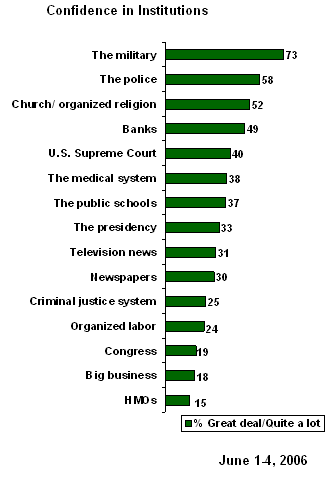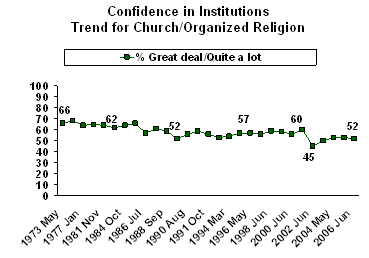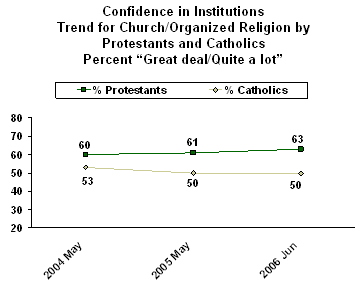PRINCETON, NJ -- Gallup's 2006 update of public confidence in the major institutions of U.S. government and society finds little change compared with last year's ratings. According to the June 1-4, 2006 poll, the military remains the top rated institution of Americans, with 73% saying they have a great deal or quite a lot of confidence in it. The police and organized religion are the only other two institutions rated that earn high confidence from a majority of Americans. HMOs, big business, and Congress earn the least amount of confidence.
The only substantial change this year is an 11-point decline in confidence in the presidency, a direct reflection of Bush's declining job approval rating over the same period. Big business also declined, by just four points. Despite recent media attention to allegations that U.S. Marines shot and killed civilians in Haditha, Iraq last November, Gallup finds no diminution in the typically high levels of public confidence in the military as of the dates of this survey.
The Rank Order
Each year Gallup asks Americans to rate the amount of confidence they have in each of 15 separate institutions as either "a great deal," "quite a lot," "some," or "very little." The resulting 2006 rank order, below, is based on the combined figures of those responding "a great deal" and "quite a lot."

The Leaders
At different times in the past, banks, the presidency, the Supreme Court, newspapers, and public schools have commanded a high degree of confidence from at least half of Americans (based on the combined percentages of great deal/quite a lot responses). However, this year the top tier group is limited to the military, the police, and the church or organized religion.
The corollary of enjoying high confidence ratings is that these institutions have low negative ratings, at least relative to the other institutions on the list. However, unlike the military and police, which have minimal levels of low confidence (6% and 12% respectively), the church/organized religion is somewhat more polarizing. While 52% have a great deal or quite a lot of confidence in the church, 21% have very little or none. This is primarily due to the more negative views of young adults and self-described "liberals" toward organized religion, possibly stemming from the Catholic Church sexual abuse scandal of 2002.
|
Top Tier Institutions - Net Confidence |
|||
|
Great deal/ |
Very little/ |
Net |
|
|
% |
% |
% |
|
|
The military |
73 |
6 |
+67 |
|
The police |
58 |
12 |
+46 |
|
The church or organized religion |
52 |
21 |
+31 |
Mid-Tier Institutions
Several organizations are rated highly by more than a third but fewer than 50% of Americans. These are banks, the U.S. Supreme Court, the medical system, and public schools. Another group -- comprised of the presidency, television news, and newspapers -- is rated highly by about a third of Americans. Except for the presidency, all of these are more likely to be viewed with high trust rather than given low ratings.
|
Mid-Tier Institutions -- Net Confidence |
|||
|
Great deal/ |
Very little/ |
Net |
|
|
% |
% |
% |
|
|
Banks |
49 |
10 |
+39 |
|
The U.S. Supreme Court |
40 |
16 |
+24 |
|
The medical system |
38 |
24 |
+14 |
|
The public schools |
37 |
25 |
+12 |
|
The presidency |
33 |
40 |
-7 |
|
Television news |
31 |
28 |
+3 |
|
Newspapers |
30 |
27 |
+3 |
Bottom-Tier Institutions
The bottom-tier group is defined as those garnering no more than 25% confidence. This inauspicious category includes health maintenance organizations (HMOs), big business, Congress, organized labor, and the criminal justice system.
Almost by definition, the bottom-tier institutions suffer from net negative ratings when taking into account the percentage saying they have very little or no confidence in each. This is particularly true for HMOs and big business, where the percentage saying they have low confidence in these is nearly double the percentage expressing high confidence.
|
Bottom Tier Institutions -- Net Confidence |
|||
|
Great deal/ |
Very little/ |
Net |
|
|
The criminal justice system |
25 |
31 |
-6 |
|
Organized labor |
24 |
28 |
-4 |
|
Congress |
19 |
35 |
-16 |
|
Big business |
18 |
40 |
-22 |
|
Health maintenance organizations (HMOs) |
15 |
38 |
-23 |
Trends Are Quiet
There have been few major shifts in public confidence this year on par with the 15-point decline in confidence in organized religion that occurred between 2001 and 2002 at the time of the Catholic Church sexual abuse scandal, or the 13-point increase in confidence in the military that occurred in the same period (following the Sept. 11, 2001 terrorist attacks).
The only substantial change found this year is an 11-point decline in the percentage expressing high confidence in the presidency, from 44% in May 2005 to 33% today. Over the same period, Bush's overall job approval rating fell by 14 points, from 50% to 36%.
The decline in confidence in the presidency is seen about equally among Republicans, independents, and Democrats.
|
Confidence in the Presidency |
|||
|
Republicans |
Independents |
Democrats |
|
|
% |
% |
% |
|
|
May 2005 |
79 |
35 |
18 |
|
June 2006 |
68 |
27 |
10 |
|
|
|
|
|
|
Change |
-11 pct. pts. |
-8 pct. pts |
-8 pct. pts. |
Confidence in big business has fallen to a new low of 18%, down from 22% in 2005. The previous low was 20% recorded in 2002, but it subsequently rebounded to 24% in 2004.
Although not significantly lower than in 2005, the 19% confidence rating for Congress today is the lowest seen for more than a decade. This comes at a time when Congress' job approval rating from the American people is also near the historic low in Gallup trends dating back to 1974. Confidence in Congress is extremely low among all three partisan groups, but especially among Democrats.
|
Confidence in Congress |
|||
|
Republicans |
Independents |
Democrats |
|
|
% |
% |
% |
|
|
May 2005 |
28 |
20 |
19 |
|
June 2006 |
27 |
18 |
13 |
|
|
|
|
|
|
Change |
-1 pct. pts. |
-2 pct. pts. |
-6 pct. pts. |
The church/organized religion has been slowly recovering from the sharp decline in confidence it experienced four years ago. It was then that allegations of sexual abuse by Catholic priests were revealed. Today, 52% of Americans say they have a great deal or quite a lot of confidence in the church or organized religion. This is similar to the 53% last year, and up from the 50% in 2003 and 45% in 2002, but is still below the 56-60% level maintained between 1995 and 2001.

Perhaps more relevant to the Catholic Church scandal: Protestants express more confidence in organized religion than do Catholics. Today, 63% of Protestants, compared with 50% of Catholics, say they have a great deal or quite a lot of confidence in the church/organized religion. This has been the case for the past three years.

By contrast, in 1991 (the last time prior to 2002 that religious preference data is available for this measure) Gallup found virtually no difference between Catholics and Protestants in their ratings of organized religion.
If the 2002 Catholic priest scandals were responsible for Catholics' lower level of confidence on this measure, it appears that the passage of time has not fully repaired the damage.
The Three Branches of Government
It is worth noting that none of the three branches of government in the United States are generating high levels of confidence from the people of the United States at this time. Americans have more confidence in the Supreme Court (40%) than in Congress (19%) or the presidency (33%), but none of the three branches inspire a great deal or quite a lot of confidence from a majority of Americans.
Survey Methods
These results are based on telephone interviews with a randomly selected national sample of 1,002 adults, aged 18 and older, conducted June 1-4, 2006. For results based on this sample, one can say with 95% confidence that the maximum error attributable to sampling and other random effects is ±3 percentage points. In addition to sampling error, question wording and practical difficulties in conducting surveys can introduce error or bias into the findings of public opinion polls.
10. Now I am going to read you a list of institutions in American society. Please tell me how much confidence you, yourself, have in each one -- a great deal, quite a lot, some, or very little? First, ... Next, [RANDOM ORDER]
|
|
|
|
|
|
|
|
Great deal/ Quite |
|
% |
% |
% |
% |
% |
% |
% |
|
|
The military |
41 |
32 |
19 |
5 |
1 |
1 |
73 |
|
The Police |
25 |
33 |
29 |
10 |
2 |
1 |
58 |
|
The Church or organized religion |
28 |
24 |
26 |
19 |
2 |
1 |
52 |
|
Banks |
18 |
31 |
39 |
10 |
* |
1 |
49 |
|
The U.S. Supreme Court |
14 |
26 |
41 |
15 |
1 |
3 |
40 |
|
The medical system |
14 |
24 |
36 |
22 |
2 |
1 |
38 |
|
The public schools |
15 |
22 |
36 |
23 |
2 |
2 |
37 |
|
The Presidency |
15 |
18 |
25 |
36 |
4 |
1 |
33 |
|
Television news |
12 |
19 |
40 |
25 |
3 |
1 |
31 |
|
Newspapers |
12 |
18 |
40 |
25 |
2 |
2 |
30 |
|
The criminal justice system |
9 |
16 |
43 |
28 |
3 |
1 |
25 |
|
Organized labor |
9 |
15 |
43 |
26 |
2 |
6 |
24 |
|
Congress |
5 |
14 |
44 |
32 |
3 |
2 |
19 |
|
Big business |
6 |
12 |
40 |
36 |
4 |
2 |
18 |
|
Health Maintenance Organizations, HMOs |
6 |
9 |
40 |
33 |
5 |
6 |
15 |
|
* Less than 0.5% |
|||||||